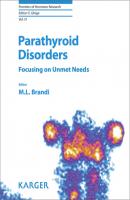Parathyroid Disorders. Группа авторов
Чтение книги онлайн.

Читать онлайн книгу Parathyroid Disorders - Группа авторов страница 16
Название: Parathyroid Disorders
Автор: Группа авторов
Издательство: Ingram
Жанр: Биология
Серия: Frontiers of Hormone Research
isbn: 9783318064094
isbn:
Effects of Medical Treatment
Medical treatment is recognized as an option for patients who have contraindications to surgery, or are unwilling to undergo parathyroidectomy [51]. In general, the consensus derived from the Fourth Workshop does not recommend dietary calcium restriction in patients with asymptomatic PHPT, while it expresses a favorable indication for vitamin D repletion, though suggesting monitoring of serum and urinary calcium excretion [51]. Supplemental doses of 600–1,000 IU cholecalciferol were considered a more prudent dosage regimen to follow than large doses. The goal of cautiously administered repletion regimens should be to increase the serum 25(OH)D levels to >50 and up to 75 nmol/L (20–30 ng/mL).
Just one study has investigated vitamin D repletion and alendronate treatment in NPHPT patients. In a prospective open label randomized trial, Cesareo et al. [52] investigated 15 postmenopausal women with NPHPT, treated with oral alendronate plus cholecalciferol (treated group) compared with 15 NPHPT treated only with cholecalciferol (control group). After 1 year of treatment, BMD increased significantly at the lumbar, femoral neck, and hip level in the treated group, but not in the control group. No differences were found between or within groups in serum calcium, PTH, and urinary calcium levels. The authors concluded that alendronate/cholecalciferol could increase BMD in postmenopausal women with NPHPT, while alendronate/cholecalciferol or vitamin D alone does not affect serum or urinary calcium. The administration of vitamin D was safe and it did not induce any cases of hypercalcemia or hypercalciuria and PTH was unaffected by the treatments [52]. Among antiresorptive drugs used to increase BMD, denosumab is a relatively new option. Its safe profile on kidney function makes it a good option for the treatment of osteoporosis in CKD; in patients with CKD, it should be cautiously managed as hypocalcemia may occur. There are no reports on the use of denosumab in patients with PHPT except for a recently published paper describing the occurrence of severe symptomatic hypophosphatemia 1 month after the administration of 60 mg denosumab subcutaneously in a patient with NPHPT and CKD stage IIIa [53].
Finally, another medical option for PHPT patients is represented by cinacalcet HCl. It is a potent CASR agonist, which normalizes serum calcium levels, reducing circulating PTH levels without normalization. Cinacalcet is recommended in those PHPT patients who need to manage hypercalcemia [51]; based on this consideration, the use of cinacalcet in NPHPT patients is not reasonable. Moreover, no data are available about cinacalcet effects in NPHPT patients.
Conclusions
Emerging data suggest that NPHPT may not be an isolated biochemical alteration but it may affect the health of patients. It appears as a disease with some clinical features overlapping those of the HPHPT and others peculiar to NPHPT. Therefore, attention should be paid to identifying PTH-related diseases involving bone, kidney, and the cardiovascular system, and, when present, therapeutic options should be considered and discussed with the patients. Alternatively, long-term follow-up should be scheduled with the patients to detect the potential progression.
References
1Silverberg SJ, Lewiecki EM, Mosekilde L, Peacock M, Ribin MR: Presentation of asymptomatic primary hyperparathyroidism: proceedings of the third international workshop. J Clin Endocrinol Metab 2009;94:351–365.
2Touvier M, Deschasaux M, Montourcy M, Sutton A, Charnuax N, Kess-Guyot E, Fezeu LK, Latino-Martel P, Druesne-Pecollo N, Malvy D, Galan P, Hercberg S, Ezzedine K, Souberbielle JC: Interpretation of plasma PTH concentrations according to 25OHD status, gender, age, weight status, and calcium intake: importance of the reference values. J Clin Endocrinol Metab 2014;99:1196–1203.
3Souberbielle JC, Cormier C, Kindermans C, Gao P, Cantor T, Forette F, Baulieu EE: Vitamin D status and redefining serum parathyroid hormone reference range. J Clin Endocrinol Metab 2001;86:3086–3090.
4Souberbielle JC, Fayol V, Sault C, Lawson-Body E, Kahan A, Cormier A: Assay-specific decision limits for two new automated parathyroid hormone and 25-hydroxyvitamin D assays. Clin Chem 2005;51:395–400.
5Harvey A, Hu M, Gupta M, Butler R, Mitchell J, Berber E, Siperstein A, Milas M: A new, vitamin D-based, multidimensional nomogram for the diagnosis of primary hyperparathyroidism. Endocr Pract 2012;18:124–131.
6Rajhbeharrysingh U, El Youssef J, Leon E, Lasarev MR, Klein R, Vanek C, Mattar S, Berber E, Siperstein A, Shindo M, Milas M: Expanding the net: the re-evaluation of the multidimensional nomogram calculating the upper limit of normal PTH (maxPTH) in the setting of secondary hyperparathyroidism and the development of the MultIdimensional Predictive Hyperparathyroid model (Mi-PTH). Surgery 2016;159:226–239.
7Lavryk OA, Siperstein AE: Use of calcium and parathyroid hormone nomogram to distinguish between atypical primary hyperparathyroidism and normal patients. World J Surg 2017;41:122–128.
8Cao S, Hu Y, Zhao Y, Su Z, Xu Z, Gao X, Liao Q, Zhao Y: A retrospective study of elevated post-operative parathormone in primary hyperparathyroid patients. Oncotarget 2017;8:101158–101164.
9Cusano NE, Maalouf NM, Wang PY, Zhang C, Cremers SC, Haney EM, Bauer DC, Orwoll ES, Bilezikian JP: Normocalcemic hyperparathyroidism and hypoparathyroidism in two community-based nonreferral populations. J Clin Endocrinol Metab 2013;98:2734–2741.
10Vignali E, Cetani F, Chiavistelli S, Meola A, Saponaro F, Centoni R, Cianferotti L, Marcocci C: Normocalcemic primary hyperparathyroidism: a survey in a small village of Southern Italy. Endocr Connect 2015;4:172–178.
11Lundgren E, Rastad J, Thrufjell E, Akerstrom G, Ljunghall S: Population-based screening for primary hyperparathyroidism with serum calcium and parathyroid hormone values in menopausal women. Surgery 1997;121:287–294.
12Garcia-Martin A, Reyes-Garcia R, Munoz-Torres M: Normocalcemic primary hyperparathyroidism: one-year follow-up in one hundred postmenopausal women. Endocrine 2012;42:764–766.
13Majid H, Khan AH, Riaz M, Karimi H, Talati J: Identifying parathyroid hormone disorders and their phenotypes through a bone health screening panel: it’s not simple vitamin D deficiency! Endocr Pract 2016;22:814–821.
14Rubin MR, Bilezikian JP, McMahon DJ, Jacobs T, Shane E, Siris E, Udesky J, Silverberg SJ: The natural history of primary hyperparathyroidism with or without parathyroid surgery after 15 years. J Clin Endocrinol Metab 2008;93:3462–3470.